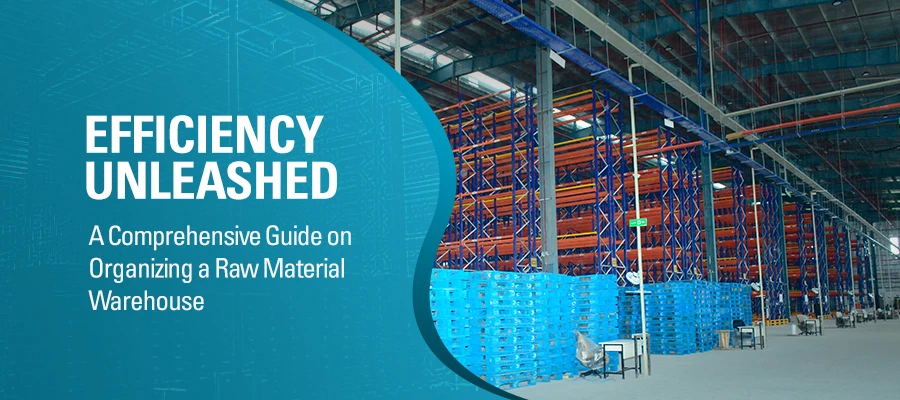Harnessing Efficiency: Warehouse Automation in the Solar Energy Revolution
In today's rapidly advancing world, the solar energy sector stands at the forefront of sustainable innovation.
Read More
In the dynamic landscape of manufacturing and production, the organization of a raw material warehouse is a critical factor that can significantly impact operational efficiency and overall business success. Establishing a well-organized and systematic approach to handling raw materials is essential for ensuring seamless production processes, reducing costs, and maintaining a competitive edge in the market. In this comprehensive guide, we will delve into the key principles and strategies to effectively organize a raw material warehouse.
At the heart of an efficiently organized raw material warehouse lies a meticulous inventory management system. This system should be designed to track, monitor, and control the movement of raw materials throughout the entire supply chain. The first step involves conducting a thorough analysis of the types and volumes of raw materials that the warehouse will handle. Categorizing materials based on factors such as size, weight, and storage requirements lays the foundation for a structured approach to organization. Utilizing advanced inventory management software can further enhance this process, providing real-time insights into stock levels, order history, and demand forecasts.
Once materials are categorized, it's crucial to establish clearly defined storage zones within the warehouse. Assign specific areas for each category of raw material, and implement a logical layout that minimizes the need for unnecessary movement. High-demand items should be strategically placed closer to production areas to reduce travel time and enhance overall efficiency. Additionally, consider the use of vertical space by implementing Shelving Systems and storage racks, optimizing the available warehouse footprint.
Labeling is an often overlooked yet integral aspect of warehouse organization. Clearly label each storage location, shelf, and container with accurate and easily understandable information. This not only facilitates quick and error-free identification but also aids in the seamless onboarding of new staff members. Standardizing labeling conventions across the warehouse ensures consistency and reduces the likelihood of confusion or misplacement.
Establishing a systematic approach to inventory rotation is essential for minimizing waste and maintaining the quality of raw materials. Implement the "first-in, first-out" (FIFO) or "first-expiry, first-out" (FEFO) principles to ensure that older materials are used before newer arrivals. Regularly conduct audits to identify slow-moving or obsolete inventory, and develop a protocol for timely disposal or repurposing of such materials. This proactive approach not only reduces the risk of product obsolescence but also optimizes warehouse space.
Investing in robust tracking and monitoring systems is a game-changer for maintaining optimal inventory levels. Barcode scanning, RFID technology, or other automated identification methods can streamline the tracking process, minimizing the risk of errors and providing real-time data for decision-making. Integrating these technologies with the inventory management system enhances visibility, accuracy, and overall control over raw material movements.
Collaboration with suppliers is another crucial element in the efficient organization of a raw material warehouse. Establish open lines of communication to ensure accurate and timely deliveries. Implement vendor-managed inventory (VMI) systems where suppliers take an active role in managing stock levels, replenishing materials based on agreed-upon triggers. This collaborative approach not only reduces the burden on Warehouse staff but also fosters stronger relationships with key suppliers.
Employee training is a cornerstone of effective warehouse organization. Provide comprehensive training programs for warehouse staff, covering topics such as inventory management protocols, safety procedures, and the proper use of equipment. Cross-train employees to handle multiple tasks, fostering flexibility and adaptability within the workforce. Regular refresher courses and ongoing professional development contribute to a skilled and knowledgeable team capable of navigating the complexities of a raw material warehouse.
Regular performance evaluations and continuous improvement initiatives are vital for refining warehouse organization strategies. Collect feedback from warehouse staff, monitor key performance indicators, and conduct regular reviews of warehouse processes. Embrace a culture of continuous improvement, encouraging employees to suggest and implement efficiency-enhancing ideas. Regularly reassessing and fine-tuning warehouse organization ensures adaptability to changing business needs and evolving industry trends.
Conclusion
The effective organization of a raw material warehouse is a multifaceted endeavor that requires careful planning, strategic implementation, and a commitment to continuous improvement. By prioritizing meticulous inventory management, establishing clear storage zones, implementing advanced tracking technologies, fostering supplier collaboration, and investing in employee training, businesses can unlock the full potential of their raw material warehouses. The result is a well-oiled operational machine that not only meets production demands but also positions the business for sustained success in the competitive marketplace.